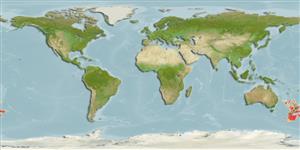ຊັ້ນຂອງກຸ່ມປາທີ່ມີຄີຫູໃຫຍ່ຄ້າຍປີກໃນທະເລ (ratfish) (chimaeras) >
Chimaeriformes (Chimaeras) >
Chimaeridae (Shortnose chimaeras or ratfishes)
Etymology: Hydrolagus: hydro-, combining form of hydor (Gr.), water; lagos (Gr.), hare, i.e., “water rabbit,” probably referring to three pairs of tooth plates, which tend to protrude from the mouth like a rabbit’s incisors. (See ETYFish); bemisi: In honor of ichthyologist William E. Bemis, now at Cornell University, “longtime mentor and friend, and a leader in ichthyological research”. (See ETYFish).
Environment: milieu / climate zone / depth range / distribution range
ນິເວດວິທະຍາ
ສັດທະເລ ກ່ຽວກັບ(ຢູ່)ຊັ້ນນ້ຳໃນທະເລທີ່ເໜີອພື້ນດິນ; ລະດັບຄວາມເລິກ 400 - 1100 m (Ref. 45044), usually 500 - 700 m (Ref. 45044). Deep-water
Southwest Pacific: New Zealand.
ຂະໜາດ / ນ້ຳໜັກ / Age
Maturity: Lm ? range ? - ? cm
Max length : 112 cm TL ຕົວຜູ້/ບໍ່ມີເພດ; (Ref. 45044)
Short description
ຕົວທີ່ໃຊ້ໃນການຈຳແນກຊະນິດ | ສະລີລະວິທະຍາ | ການວັດແທກຮູບຮ່າງລັກສະນະພາຍນອກຂອງດິນ,ສັດ,ປາ…
Pale brown coloration fading to white ventrally. Dorsal fin spine reaching to origin of second dorsal fin when depressed; elongated second dorsal fin not indented along its length. Horizontal and hyomandibular lateral line canals sharing a common branch. Caudal filament long and stout (Ref. 45044).
Oviparous (Ref. 205). Eggs are encased in horny shells (Ref. 205).
Life cycle and mating behavior
Maturities | ການສືບພັນ | Spawnings | Egg(s) | Fecundities | ຕົວອ່ອນ
Didier, D.A., 2002. Two new species of chimaeroid fishes from the southwestern Pacific Ocean (Holocephali, Chimaeridae). Ichthyol. Res. 49(4):299-306. (Ref. 45044)
IUCN Red List Status (Ref. 130435)
Threat to humans
Harmless
Human uses
ເຄື່ອງມື
Special reports
Download XML
ແຫຼ່ງອີນເຕີເນັດ
Estimates based on models
Preferred temperature (Ref.
123201): 5.4 - 9.5, mean 7.1 °C (based on 125 cells).
Phylogenetic diversity index (Ref.
82804): PD
50 = 0.5000 [Uniqueness, from 0.5 = low to 2.0 = high].
Bayesian length-weight: a=0.00380 (0.00194 - 0.00745), b=3.09 (2.91 - 3.27), in cm total length, based on LWR estimates for this species & (Sub)family-body (Ref.
93245).
ຊັ້ນເຂດຮ້ອນ (Ref.
69278): 3.9 ±0.6 se; based on size and trophs of closest relatives
ຄວາມຢືດຢຸ່ນ (Ref.
120179): ຕຳ່, ປະຊາກອນຕຳ່ສຸດທີ່ໃຊ້ເວລາສອງເທົ່າ 4.5 - 14 ປີ (Assuming Fec <100).
Fishing Vulnerability (Ref.
59153): High to very high vulnerability (67 of 100).
